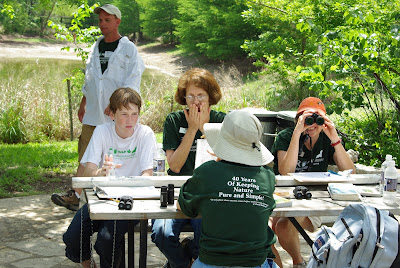The highlight of the week was when 155 people gathered at the Center as witnesses to the marriage of Justin Duke and Stephanie Tidmore. The relatives and guests came from parts of Texas and as far away as Omaha, Nebraska. Rain clouds threatened all around, but the sun did shine on this young couple throughout the event. Justin, a graduate of Texas State University, has been with Selah 1 ½ years assisting with education programs and in habitat management. Stephanie is an LVN working at the Live Oak Medical Center in Blanco. She also volunteers here at the ranch on her days off.

Justin and Stephanie exchanging their vows.
Photograph taken by Shelley Duke, Justin’s sister.

Here’s Justin and Stephanie’s first dance.
Photograph taken by Shelley Duke.

Justin and Stephanie will live in this house under construction here on the ranch.
Photograph taken by J. David Bamberger.
Not politics – just a good citizen. I’ve always fostered the ethic of volunteerism and encouraged those who work here to give back to our community with their time and experience. Our Executive Director, Colleen Gardner, has been good about that with membership in the Johnson City Women’s Club- whose principle mission is funding the library, a Directorship on The Hill Country Alliance and by giving many programs on bees and land stewardship to schools and civic organizations. This week she was sworn in as Precinct 2 Director of the Blanco Pedernales Groundwater Conservation District.
.jpg)
Judge Carter swears in Colleen Gardner, Tom Morrow and Jimmy Klepac.
Photograph taken by Linda Vincent.
Interns are important to us for a number of reasons and it’s not just that they participate as willing workers. No, we feel it’s important that young people contemplating a career in conservation or environment or any form of agriculture for that matter spend some quality time in the natural world – such as a ranch, tropical rainforest or with a conservation organization. Here at Selah we enjoy and welcome the opportunity to take young people and awaken and nourish a passion for learning in them, especially regarding the natural world.

Here is Emma Hine, one of our summer interns, on her first day of “work” during our family picnic. Emma has just graduated from St. Andrew’s High School in Austin and will be attending Washington University in St. Louis. She plans to major in English.
Photograph taken by Kathy Wilson.

Samuel Marsh began his internship on May 29th. He is welcomed by Colleen Gardner, Executive Director, and J. David. Sam is attending Southwestern University in Georgetown, TX and will be with us until mid July.
Photograph taken by Lois Sturm.
Our Texas Parks and Wildlife Department organized a “media tour” here on the ranch on Tuesday, May 26th. What is a media tour? To us, it’s another form of “people ranching”; although it’s more “show and tell” than education. Representatives from all forms of media came to be enlightened by the many accomplishments and conservation practices we have instituted here over the past 40 years. It was a good day for us as representatives were here filming, interviewing and photographing the ranch from CBS KEYE-TV 42 in Austin, Express News from San Antonio, KSAT-TV 12 from San Antonio, The Austin American Statesman newspaper, National Public Radio, Texas Co-Op Power Magazine, Texas Wildlife Association, Sand County Foundation from Wisconsin and, of course, our many friends from our own Texas Parks and Wildlife Department. We did our best to show them all a good time and ended their day with a lunch at the Center. Look for their articles, pictures, and stories. Some links can be found on our website: www.bambergerranch.org.
.jpg)
J. David welcomes everyone at the Historical Marker, our traditional meeting and greeting place for visitors to the ranch. The burial spot with the tombstone contains the following epitath: “In Memory of Man . . 2,000,000 BC – 20? AD . . . He who once dominated the earth destroyed it . . . with his wastes, his poisons, his own numbers.” Photograph taken by Colleen Gardner.
.jpg)
Steven Fulton, Ranch Biologist, demonstrates our Rain Machine for the media. The Rain Machine simulates a one inch rainfall on two different types of rangeland, one being a cedar infested forest and the other a grassland. It gives a dramatic visual illustration of what we did here at Selah and how it produced “Water from Stone.”
Photograph taken by Colleen Gardner.











































